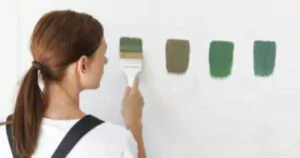So you’ve decided to paint a room or hallway in your home. You might consider tackling the job yourself rather than hire residential painters. Before you do, consider a few mistakes people make in painting rooms.
1. Purchasing Cheap Brushes and Rollers
A home improvement store trip may convince you to buy cheap brushes and rollers, but it will hurt your quality of work in the long run.
Cheap paintbrushes can damage your walls. The material on cheap rollers can wear down, causing your paint to go on unevenly. You’re going to have to replace these tools, so investing in quality brushes and rollers initially is a smart way to avoid painting restoration later on.
2. Skipping The Prep
It is not unusual to be excited about painting a room a new color. But don’t skip the step of preparing the walls. Filling in wrinkles and holes with spackle and waiting for them to dry are two things to do before painting.
Also, if you apply the tape to the top and bottom edges of your walls and around your windows and doors, your painted surface will have even, sharp edges. Taking care of your preparation will yield a higher quality product and not require painting restoration.
3. Exchanging Painters Tape For Masking Tape
Using any tape other than painter’s tape can create problems. This is true with masking tape, too, since it tends to absorb the paint, causing the color to bleed into spaces where you don’t want it.
Additionally, masking tape tears quickly while it’s being used, making the job less exact, compared to painter’s tape that won’t absorb color and makes the task more precise. Painter’s tape is resilient and easy to apply to edges and around corners.
4. Not Applying Primer
It may be tempting to skip the application of primer. However, it holds a definite function since it conceals imperfections and allows you to cover your walls with dark paint efficiently.
Also, primer affects the color of your wall by preventing bleed-through of the color underneath.
5. Painting Over Wallpaper
If you wish to paint a wall covered in wallpaper, it’s recommended that you remove it first. But if you decide to paint over the wallpaper, you need to prime the wall with an oil-based primer first.
You should avoid using water-based primer on the wallpaper, as this can cause problems with the glue. Failing to follow this guideline can add a lot of stalling and time to your painting task.
Related Post: Preparations Before the Painting Service Arrives
6. Not Choosing The Proper Finish
The paint finish you select may seem trivial, but it can have a significant impact. If you are painting a high-trafficked area in your home, it is best to pick satin or semi-gloss finish. When it comes to fingerprints and smudges, a semi-gloss or satin finish is easier to clean. On the other hand, a flat finish is more difficult to clean. Knowing what type of finish to use will impact the appearance of your walls long-term.
7. Using Incorrect Technique
A common mistake is to dip the brush or roller too deep in the paint, which leaves too much on the brush or roller, making it challenging to apply it evenly to the wall.
One way to get just adequate paint on the wall at a time is to dip the roller or brush about 1/3 of the way into the paint. Also, work your way down from the top to prevent drips.
You might like: What Should I Look For In A Painting Contractor?

If you pay attention to your painting methodology, you will see that the paint is applied in a consistent, balanced manner.
And remember, you can always consult a professional painter in Santa Fe area if you feel that you have bit off more than your can chew. It may be wiser to leave it to a professional.





